On June 8, 1924, at 12:50 PM, climber and geologist Noel Odell scrambled to the top of a small rock tower on the North Ridge of Mount Everest. Excited at having found the first definitive sea fossils on the mountain, he gazed expectantly across the rocky massif toward the Northeast Ridge above; he knew that somewhere in that vast and frightening landscape, his friends were making an attempt on the summit.
Little did Odell know that what he saw next - and his recollection of it - would be the source of constant debate for 100 years, a debate of intensity and scrutiny, a keystone of our comprehension of the final days and hours of George Mallory and Andrew Irvine.
Odell wrote several iterations of his sighting - in his diary and various other publications - but the general gist is fairly consistent:
At 12.50, just after I had emerged in a state of jubilation at finding the first definite fossils on Everest, there was a sudden clearing of the atmosphere, and the entire summit ridge and final peak of Everest were unveiled. My eyes became fixed on one tiny black spot, silhouetted on a small snow crest beneath a rock step in the ridge, and the black spot moved. Another black spot became apparent, and moved up the snow to join the other on the crest. The first then approached the crest rock step, and shortly emerged at the top. The second did likewise. Then the whole fascinating vision vanished, enveloped in cloud once more. There was but one explanation. It was Mallory and his companion, moving, as I could see even at that great distance, with considerable alacrity, realizing doubtless that they had none too many hours of daylight to reach the summit from their present position and return to Camp VI by nightfall. The place on the ridge mentioned is a prominent rock step, at a very short distance from the base of the final pyramid, and it was remarkable that they were so late in reaching this place.
- Noel Odell, The Alpine Journal, Volume 36, Issue 229
Some of Odell’s wording - and thus interpretations of precisely where the two climber’s were sighted - changed enough in various writings and recollections to be of importance, but that is a subject for another post and discussion. Here, today, I’m more concerned with what precisely Odell could have seen on that fateful day 99 years ago. Namely:
- Could he have seen what we now know as the three steps - First, Second, and Third - from his position?
- Could he have mistaken one for the other, gotten them confused?
- And, could he have seen people moving on the Northeast Ridge from his viewpoint?
To answer the first question, let’s take a look at what Odell was up to that day. His main prerogative was to ascend from Camp V to Camp VI in support of Mallory and Irvine. Odell - an incredibly strong climber and geologist by career - was focused on his support role but also in “conducting as wide a geological survey…as possible.” To that end, Odell was exploring a bit, and just before 12:50 PM, he “climbed a little crag,” he wrote in The Fight For Everest 1924, “which could possibly have been circumvented, but which I decided to tackle direct, more perhaps as a test of my condition than for any other reason.'' It was atop this “little crag” of about 100 feet that he saw the figures moving.
So, where was this crag, where was Odell, and what could he see?
Unfortunately, we don’t know - and likely never will - Odell’s precise location. The only indications are that he planned to take a “circuitous route” to Camp VI to inspect the North Face, indicating he would break off the North Ridge proper. And, we know it took him roughly 5 hours to get to his crag from Camp V, and another hour to arrive at Camp VI. We also know Odell was dawdling, exploring, hunting for fossils, as his six hours between camps was quite slow for him. Thus, we can only presume his crag, his viewpoint, was a slow(ish) hour from Camp VI, and likely off the North Ridge on the North Face.
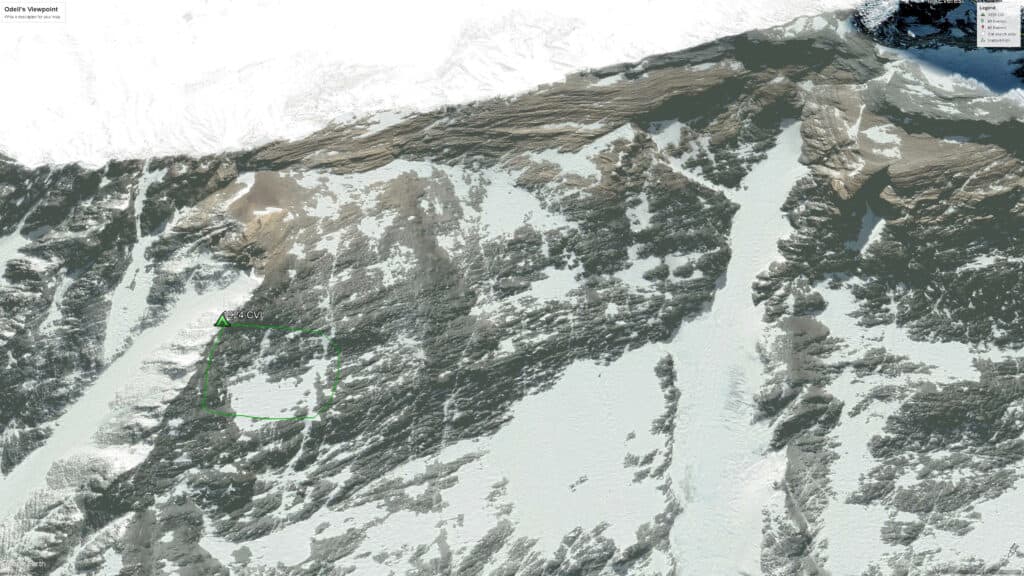
Fortunately, not knowing precisely where he was standing is not a big issue for us, as we know something more important: Odell was a climber and a geologist. As both, he knew to look at rocks, features, routes, strata, banding, and more. His climbing background - and his weeks on Everest up to that point - would have burned the features of the Northeast Ridge into his mind. Any climber who’s been in as-yet-unknown terrain understands how closely one surveys the landscape, the features, the challenges and pitfalls, hard ground and easy ground.
For months, the team had been approaching and climbing the mountain, forever discussing and analyzing the challenges that lay above the highpoints of 1922. They studied photographs, discussed options, and with every step stared at the terrain ahead. From Basecamp and from nearly every step above the North Col, the Northeast Ridge is in full view, its ferocious landscape staring down in challenge. It is unfathomable that Odell would have seen a foreshortened view of the Ridge and not known the difference.
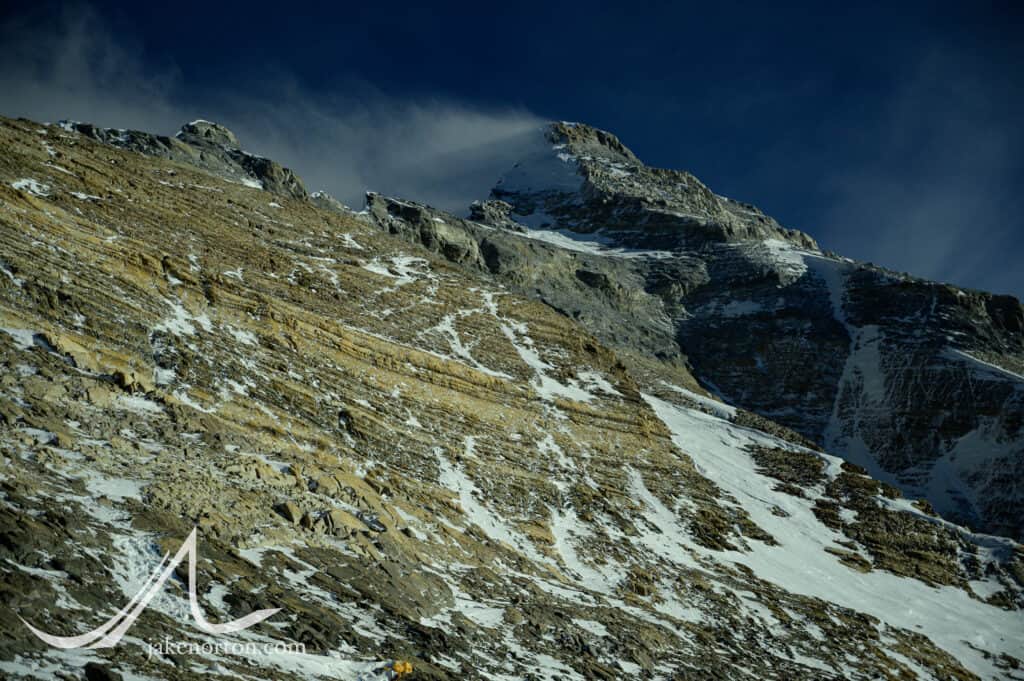
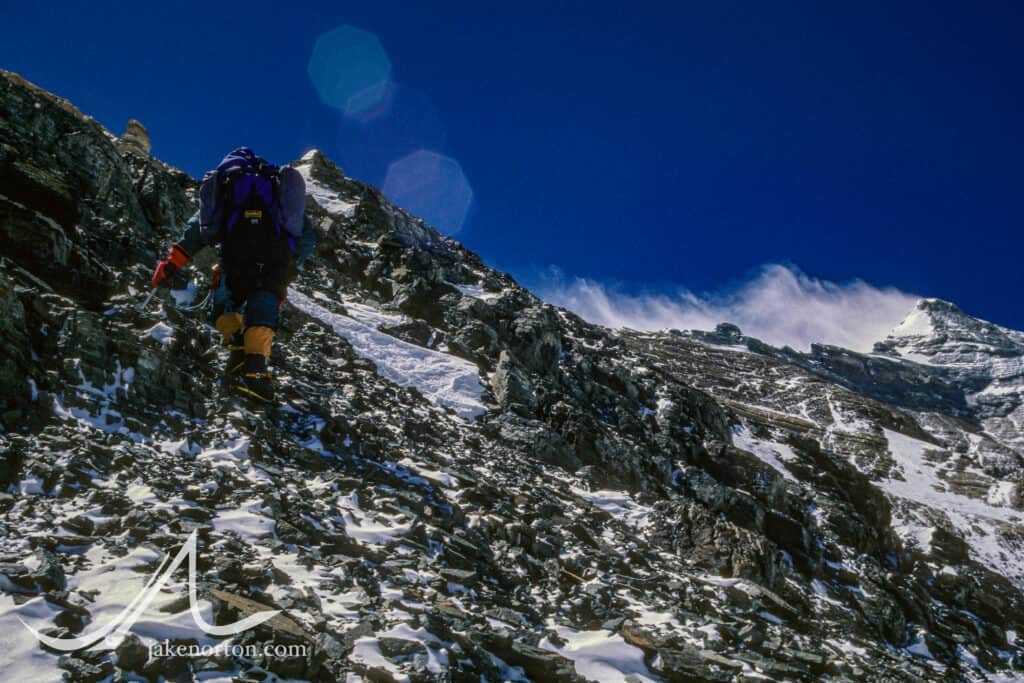



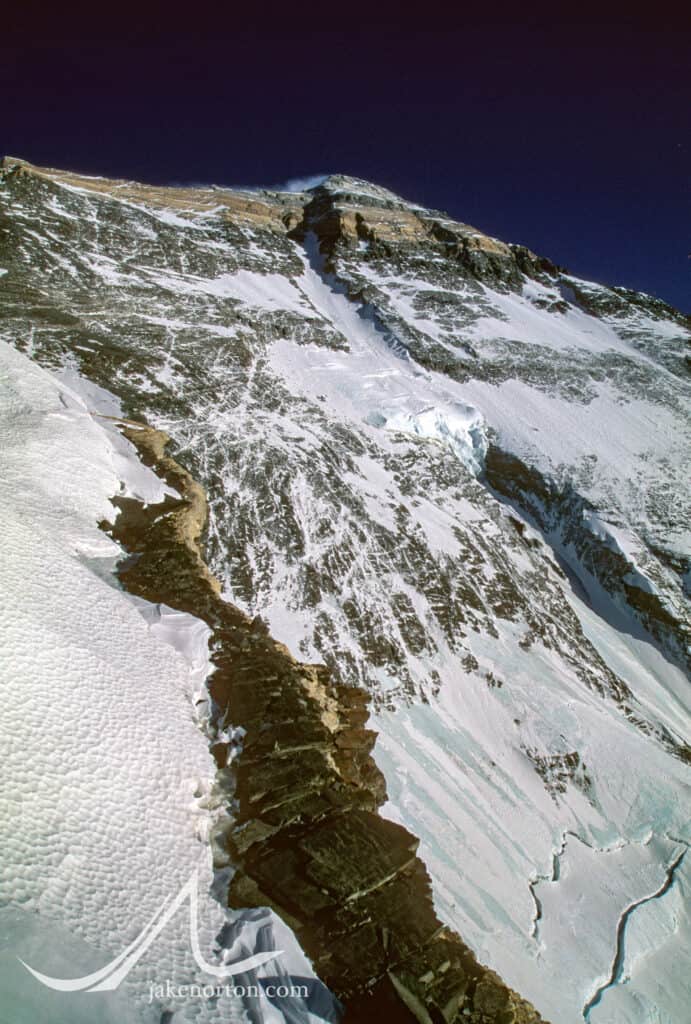
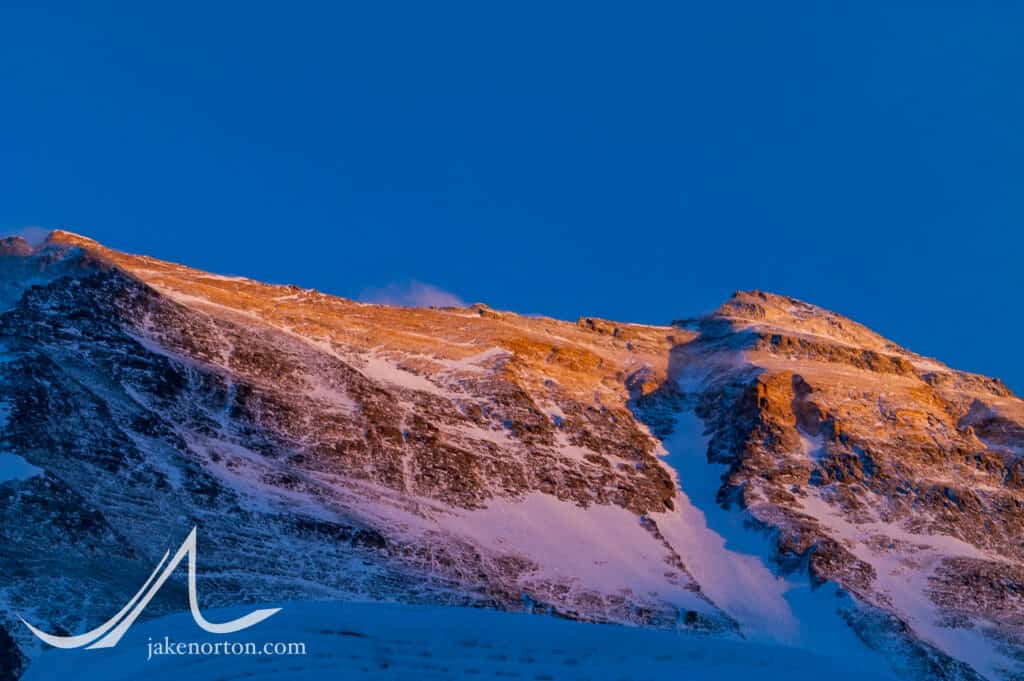
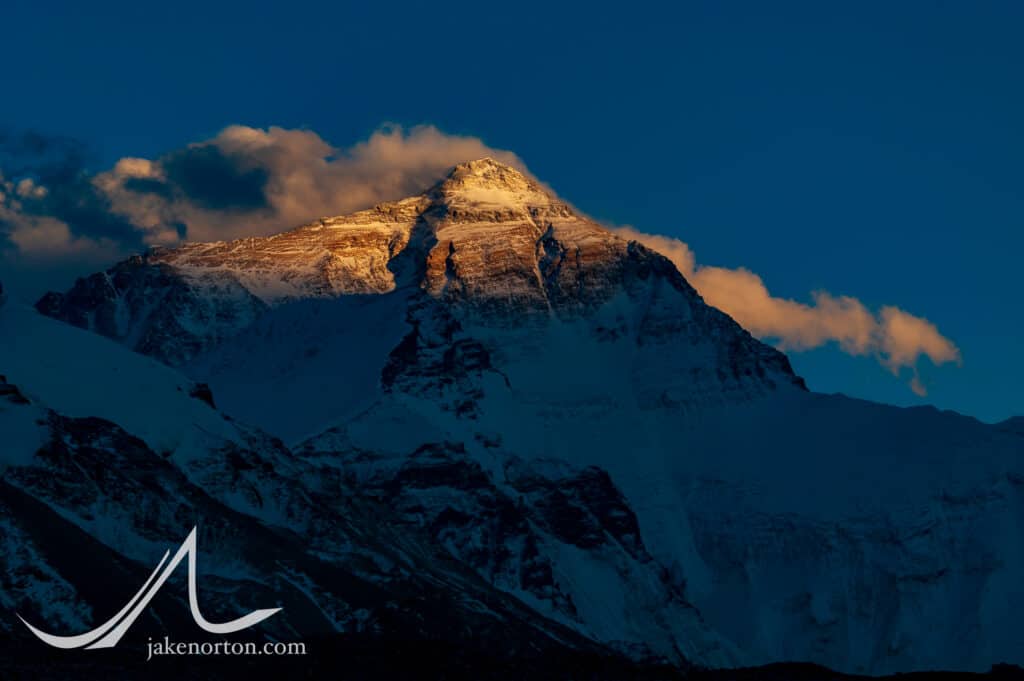
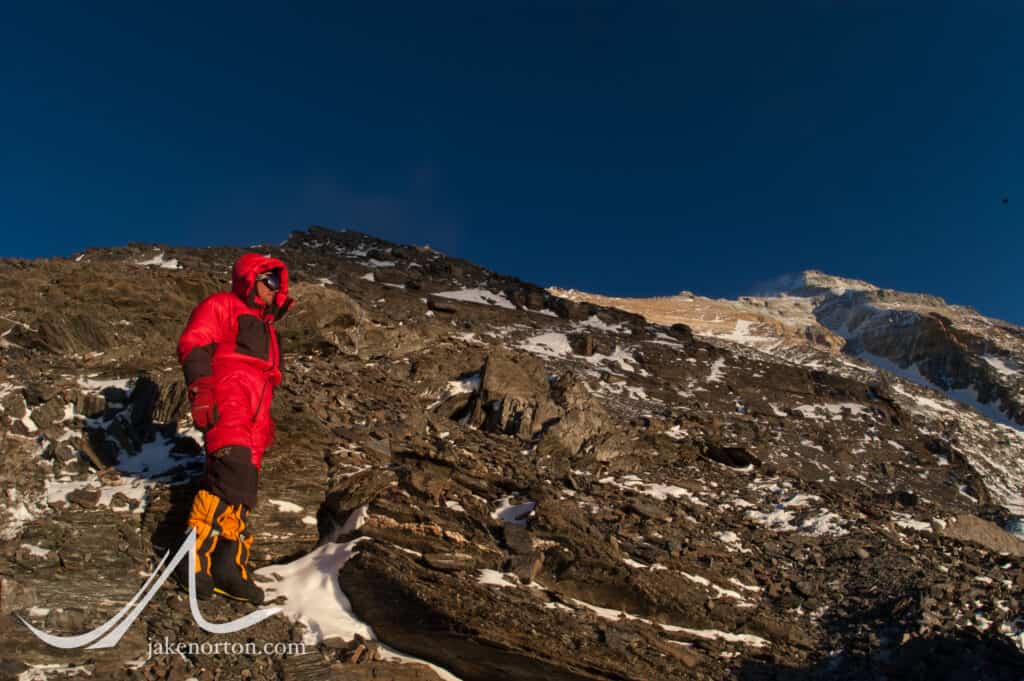


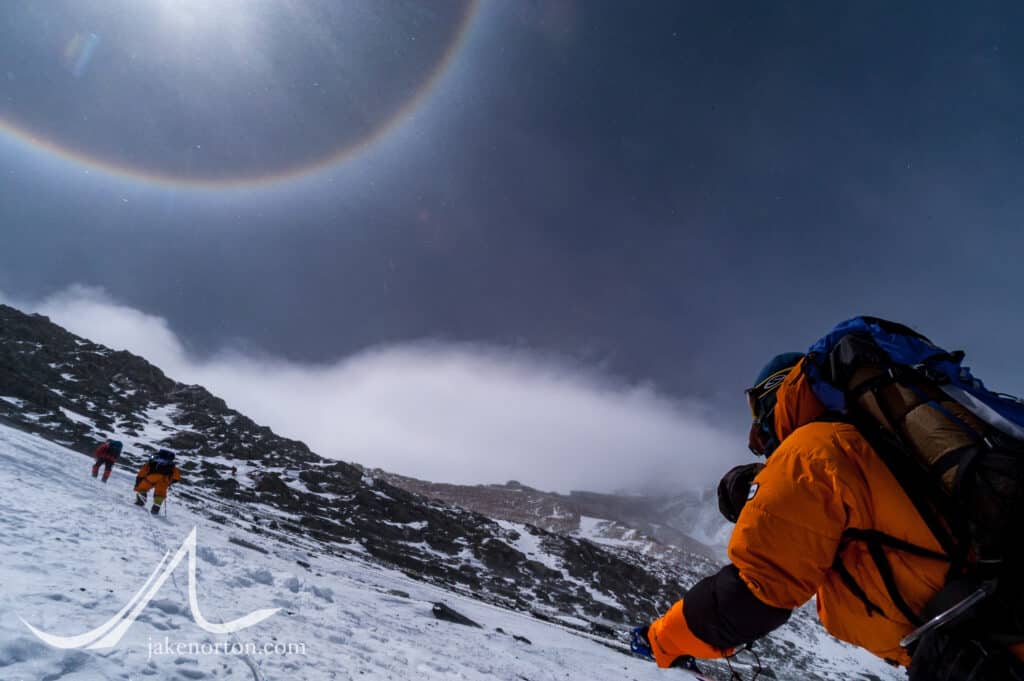
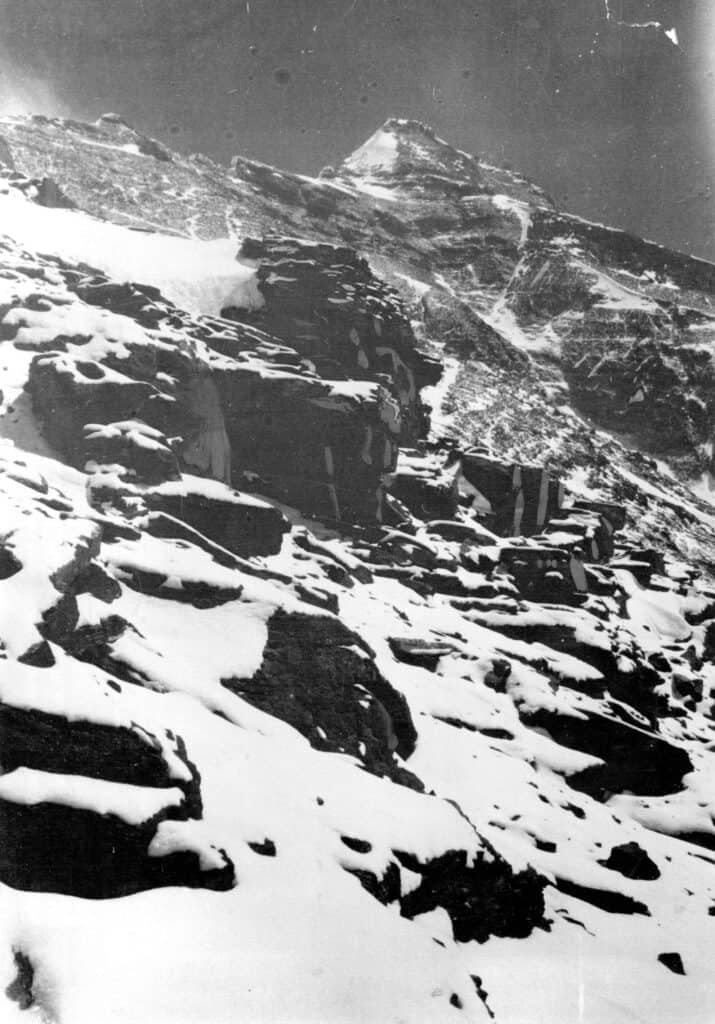
As for mixing up the Steps - confusing the First with the Second - that, too, seems impossible, as they are remarkably different features. The First from all perspectives is rounded, benign, seemingly more a lump on the Ridge than a major obstacle. The Second Step, however, is markedly different: An 80 foot vertical jag sticking like a ship’s prow from the crest, it is vicious, violent, malevolent, unmistakable. As for the Third Step, from all angles (and from reality), it appears as less of a step than a broken extension of the grey band running along the base of the summit pyramid, and was not referred to as a step in its own right in 1924.
To my mind, then, it defies logic to presume Odell either (a) could not see the full climbing route and did not realize it, or (b) confused the Steps.
So, assuming he could see the Steps clearly and knew which was which, could he have even seen people climbing them from his vantage point?
The simple answer is: YES.
To dive a bit deeper, let’s first think about Odell’s location. We know he was on a bit of a walkabout, exploring and finding fossils, and wrote his plan was to veer off the North Ridge proper onto the North Face to explore. This deviation would put him closer to the modern climbing route - which does exactly that - than the route direct from 1924 Camp V to Camp VI. Additionally, we can infer from his times that he was likely fairly high above Camp V, as it took him 5 hours to get to his crag, and only one additional hour to get to Camp VI. Thus, we can realistically place Odell out on the North Face, near the modern climbing route, and relatively high in relation to 1924 Camp VI.
It might be somewhere quite close to where I took this photo of Dave Hahn in 2004:
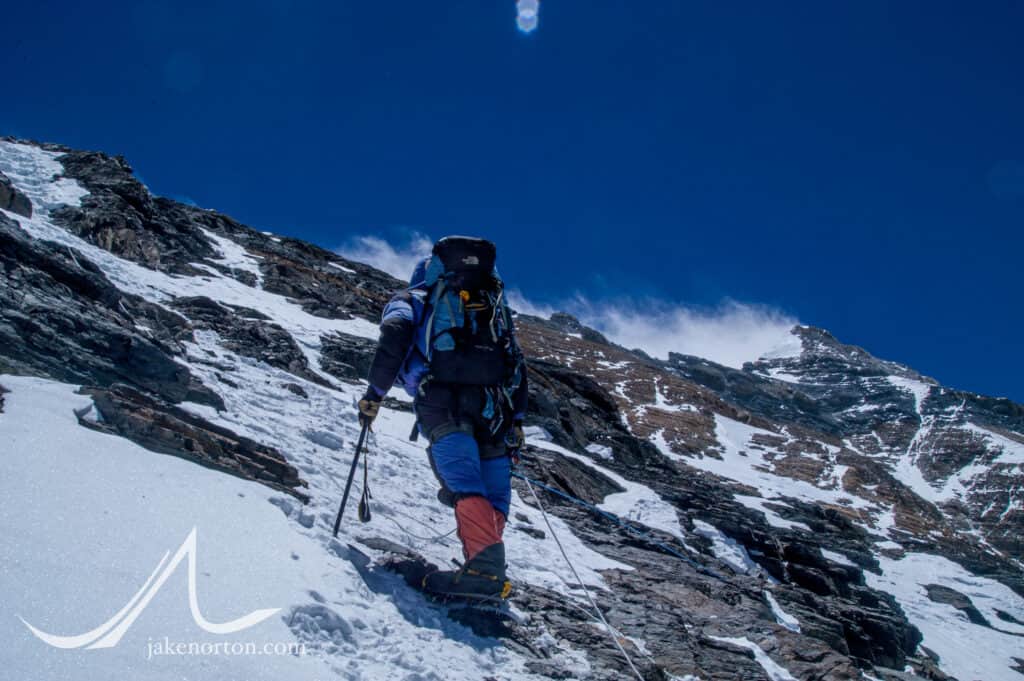
Just seconds after snapping that shot - 27 seconds after, to be precise - I glanced up again and saw people moving atop the Second Step and snapped a second photo:
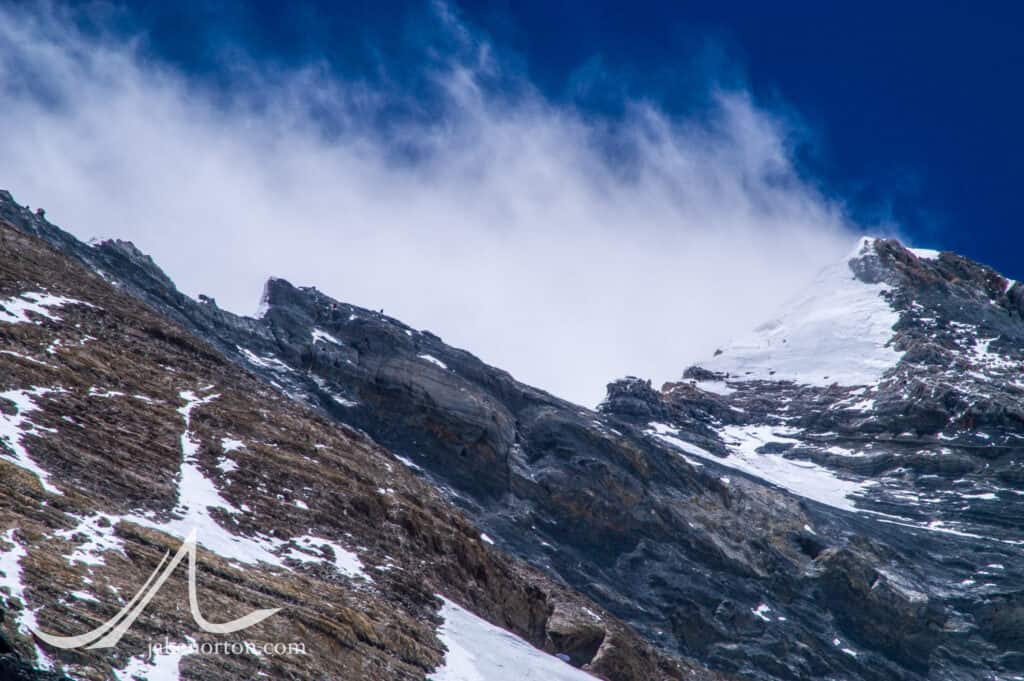
You can clearly see the silhouettes of people atop the Second Step, and if you look closely, you’ll see another person left of Mushroom Rock, one about to rappel the ladder on the Second Step, and three people above the Third Step. But, a camera lens is not a human eye, and I told you where to look. So, can we replicate what Odell’s view might have been?
The first photo was shot on a modern (at the time) camera (Nikon D100) with a 24-120 mm lens at 24mm. The D100 has a crop sensor, so the 35mm equivalent focal length would be about 36mm. In doing some research online, I found that the human eye’s view is roughly equal to using a 50mm lens on a 35mm camera. To make the first photo more like what Odell would have seen, I cropped in 23% to get a roughly correct angle of view using data from this Nikon page. (Nota bene: I’m admittedly awful at science and math, so please let me know if I’ve mudged this up!) Here’s the result:
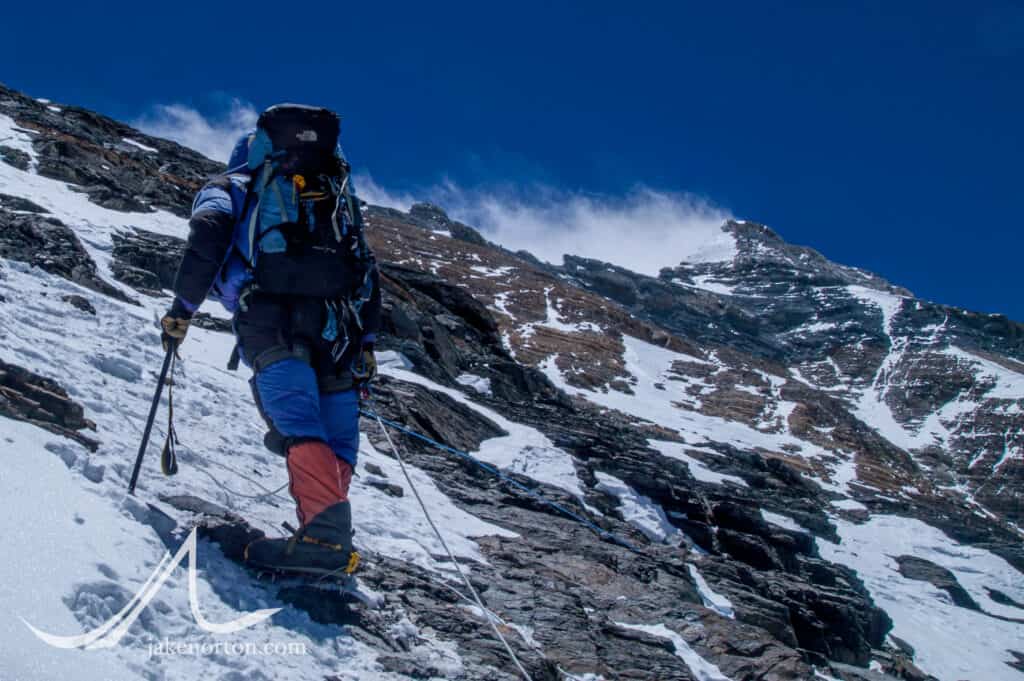
Assuming my data above is correct, this makes everything a bit closer, a bit bigger, a bit easier to see.
Now, take the second image. I saw the people moving with my eyes, but using my camera zoomed in to 120mm, which on the D100 is equal to about 180mm. Obviously, that is quite a bit more than the 50mm we’re looking for: it's a lot "closer," and thus not a good representative of what Odell might have been able to see. So, I took that shot, added it as a layer in Photoshop atop the prior image, and using content aware scaling and Puppet Warp I resized it to match closely the features and keeping scale and ratios in mind. The result is below in a still image:
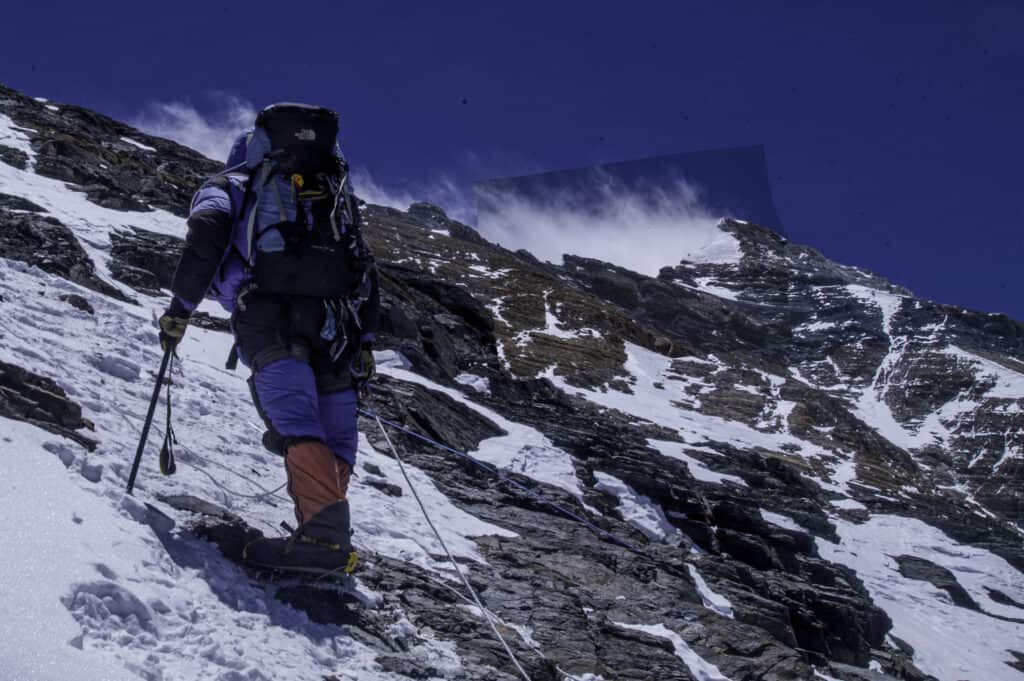
While not perfect, you can pretty clearly see the person atop the Second Step. Want to make it a bit more accurate? If you print this PDF (on a good printer with good paper, and print fullsize without any scaling or "fitting to printable area") and hold it about 23 inches away from your eyes in good, bright light, you should be replicating essentially what my eyes saw on that day in 2004. (Want to dork out on all of this? Check out this discussion on StackExchange.) Can you see the climbers now? Pretty tough, but now imagine they’re moving. Yeah, a bit easier - as I found in 19 years ago - but still not easy.
The big question remains: Could Odell have seen them? It seems, from the above, that he certainly could have, especially if he knew where to look. And, if we believe his words to be true, then he did see something on the Ridge that day. Since he only had a few moments to make his observation before “whole fascinating vision vanished, enveloped in cloud once more,” it stands to reason that the first place Odell’s eyes went - and the place he honed in on, expecting to see the duo - was on the ridge crest.
Odell’s sighting and his statements about it have been called into question many times in the intervening years. He even changed his position on the location of the climbers a couple of times, but ultimately he steadfastly stuck to his story, insisting that he saw Mallory and Irvine - not rocks, not illusions - moving. (See my story here about Glenn Porzak’s encounter with Odell shortly before his death.) Want to hear it from the man himself, backed up by Sir Chris Bonington? Watch this video below from the cued starting point, or for extra credit watch the whole thing:
In the end, we still don’t know where Odell was with precision. But, I feel strongly we do know what he could see, can realistically assume he knew what he was looking at, and we have his word on what he saw: two climbers moving, with alacrity, at “the last step but one from the base of the final pyramid.”
Still so much to learn, so much to understand, but I think we can take questions of whether Odell could see people on the Ridge, and whether he got confused about the Steps, out of our questioning.
What do you think? I'd love to hear feedback on the above!
Note: In writing this, I’ve had some additional thoughts about what Odell might have seen and where he saw the climbers. I’ll get that out next week. And, for anyone wanting to dive deeper into all of this, please hop on over to the unDefined Community and read the posts and comments on this subject by Darren Wisniewski (see the PDF he attached to his initial post), the post by Carl Arnst and subsequent comments by Robert Edwards and others, and also the comments on my post here.)
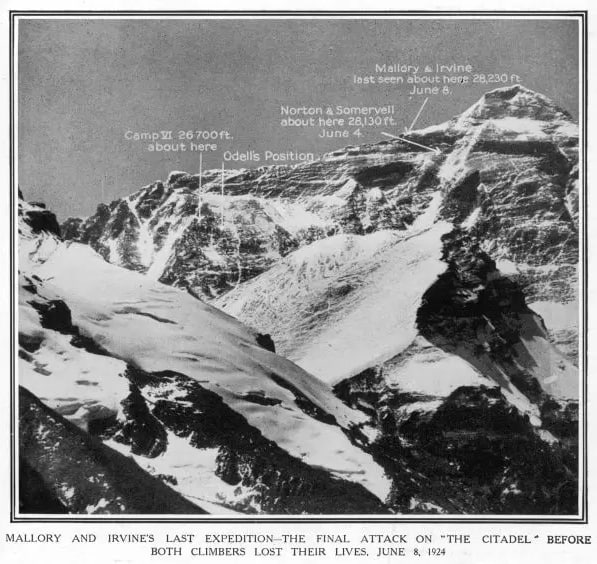
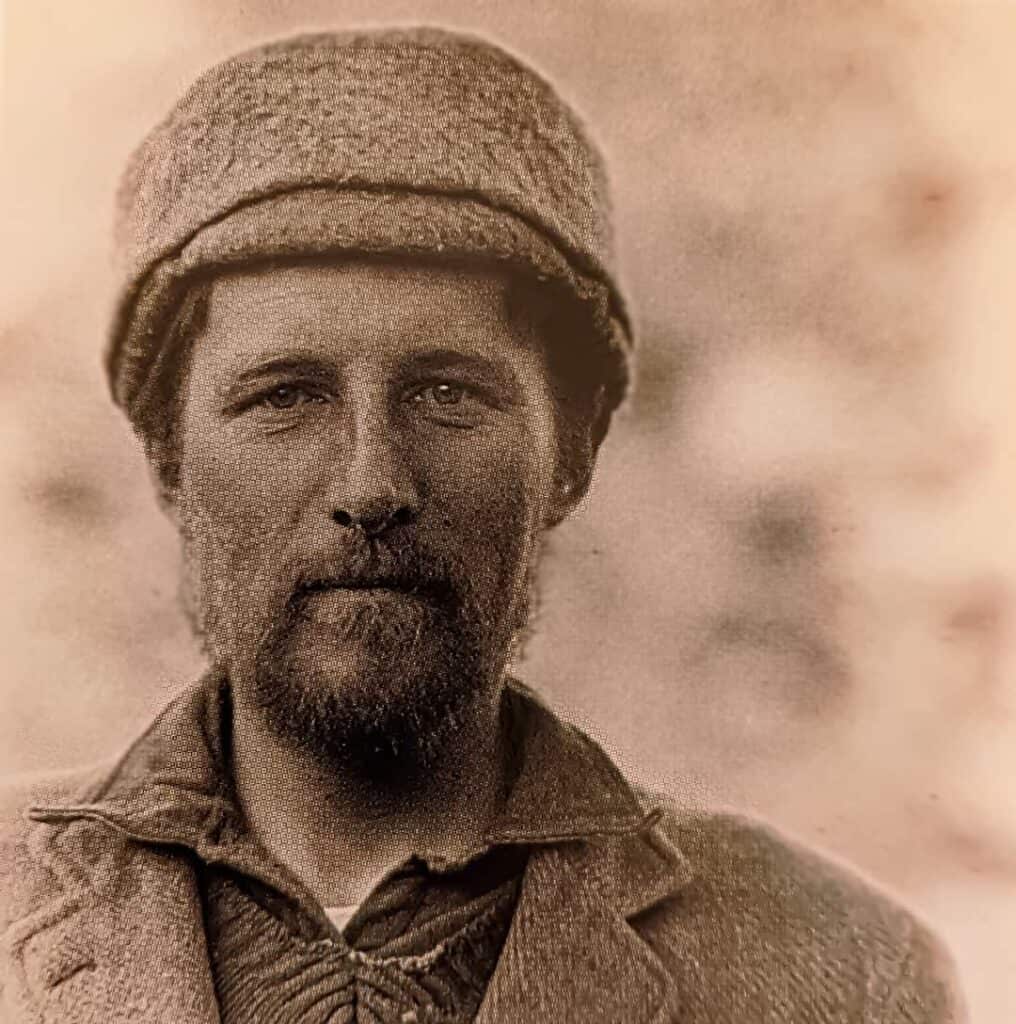
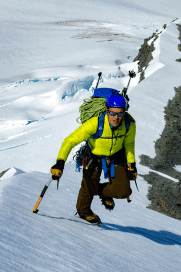

An aspect of the discussion is whether they were seen at the second step or third step, or somewhere else. Would it have been possible for Odell to have seen them at the third step?
The wording is vague. What is a "step"? We use different words to describe the scene today than they used in 1924. I look at your picture and I see another possibility. Look at that triangular patch on the pyramid. At the bottom of that patch is a band of dark rock. Below that is another snow patch. The dark band is likely dark because it is steeper than where the snow is, too steep to hold snow. This could be considered to be a step at "a very short distance from the base of the final pyramid." Our terminology didn't exist in 1924. There was no standard route labeling then. It is very unlikely that they could have climbed the Second Step during Odell's brief view, and "shortly emerge at the top", especially with Irvine being in the bad condition he was in. Is it possible Odell saw them crossing this band? Could he have seen them there? I believe the pyramid seen here is not actually the final pyramid. Not known to Odell then, since no one had been there, The final pyramid is hidden from view until you emerge at the top of what we see here.
Thanks for your comment, Gary, and your thoughts on all of this.
Indeed, it is difficult to sort out given Odell's somewhat vague wording, and the fact as you note that the nomenclature of the Northeast Ridge was not nearly as defined in 1924 as it is now.
The team did refer to the first and second steps by those names, but not in a formal sense and there was not a mention that I know of of the Third Step.
I hadn't thought previously about the little steep band above the Third Step possibly being the sighting spot Odell referenced. Very interesting indeed. Thanks!
Dear Jake,
thanks for summarizing this so neatly, and illustrating it with your exquisite photography.
If one goes by Odell's testimony alone, there is little doubt that he saw Mallory & Irvine at the Second Step. In one of his early accounts he described the spot as "the last step but one" from the base of the final pyramid, and later gave the altitude as 28,230 ft., then the accepted altitude for the top of the Second Step. This nails it down pretty well and also shows that Odell was aware there was yet another step – a "last step" – above the Second.
To me, the question remains whether the climbing Odell describes really fits the Second Step. The climbing is in three parts: 1) the approach to a step via a snow-crest beneath, 2) the actual climbing of a rock-step within the time of his sighting, and 3) the emerging of one or both climbers at the top of the step, silhouetted against the sky.
When I observed our 1999 team on the various steps through a telephoto lens from above ABC – from roughly the same angle as Odell's sighting, but twice as far away – I found it hard to believe that the snow patch on the Second Step was the snow crest or slope beneath the step that Odell had described. The patch is small, indistinct, and also mostly in the shadows. In fact, only when I looked at my slides later could I spot Conrad and Dave's red down suits. As for the actual climbing of the step, it is open to debate whether the Second Step could have been climbed without fixed ropes or ladders within the time of Odell's sighting. The First Step probably could have, and the Third Step certainly could have. On all three of the steps climbers do emerge silhouetted against the skyline when topping out, although on the First Step it is on a ledge at half-height, to the right of the actual top (though we might be talking semantics here).
Going by visual observation alone (as opposed to testimony), my personal impression was/is that the Third Step fitted the climbing sequence described by Odell best – almost step-by-step, actually – while there were problems in certain details of the First and Second.
Plenty food for thoughts indeed... 😉
Thank you, as always, Jochen. Your perspective and knowledge are always enlightening!
I keep wondering why Odell would have chosen his language - last step but one - to describe where they were when it seems they were using the labels of first and second steps at that time. Seems strange, but then again so much of this mystery seems strange!
Like you, I find the timing with the Second Step problematic. I have no doubt Odell could have seen them atop the Second, but see them climbing it? Assuming they went up the standard corner, I don't see how he could possibly have seen them. As you note, the Third Step seems to fit best with the descriptions, but not the altitude and the certainty Odell seemed to have through his life that it was the second. Argh! Hard to decipher!
The altitude may have been adjusted later to conform with his revised understanding. How would he have known the altitude at that time? With a precision of 30 feet? That number would not have come from 1924, but a later expedition.
Perhaps one of you can correct me if I'm wrong, but the earliest accounts we have from Odell were from his diary entry and the dispatch he sent the next day to Norton.
Odell's diary records, "M + I on ridge nearing base of final pyramide"
Norton's initial account: "Mallory and Irvine were last seen by Odell from VI (12:50pm Jn 8th) 'going strong' about the final step before the pyramid"
Then when Odell returned to base camp, he gave another description: "...one tiny black spot silhouetted on a small snow crest beneath a rock step in the ridge...the place on the ridge referred to is the prominent rock step at a very short distance from the base of the main pyramid"
The accounts speaking of "last step but one" were not until several months later, when Odell had returned to England.
It strikes me that Odell's earliest accounts seem to almost perfectly describe the 3rd step, and then as time goes on the accounts shifted subtly to sound more like the 2nd step. I'm not sure what to make of that, but it seems important.
Hi Dan, thanks for your great comment, and sorry for the delayed reply. I have been way behind on things!
Anyway, I'm with you: the evolution of the descriptions is troubling, and not sure what to make of them. I do think, like you, that it is important though. I guess much of my feeling has come from believing that the very first accounts were abbreviated, not much detail but rather passing along information about rough locations, etc. The middle description - "the place on the ridge referred to is the prominent rock step at a very short distance from the base of the main pyramid" - to me seems more accurate. Odell by this time had time to write more detail, think more clearly, etc. But, to me that description - when our modern parlance of First, Second, and Third Steps - is taken out of the equation, still points to the Second Step. As I see it, and as I believe they saw it, for they never mentioned a "third step," the "prominent rock step" fits the Second Step to a "t." If you take the image below - taken by me in 1999 as we moved between Camps V and VI - the Third Step is not really a pronounced feature so much as a toe at the base of the final pyramid - and this is similar to Odell's viewpoint:
And, this shot, taken in '22 from the no-O2 highpoint, shows a similar view with the Third Step kind of a non-event:
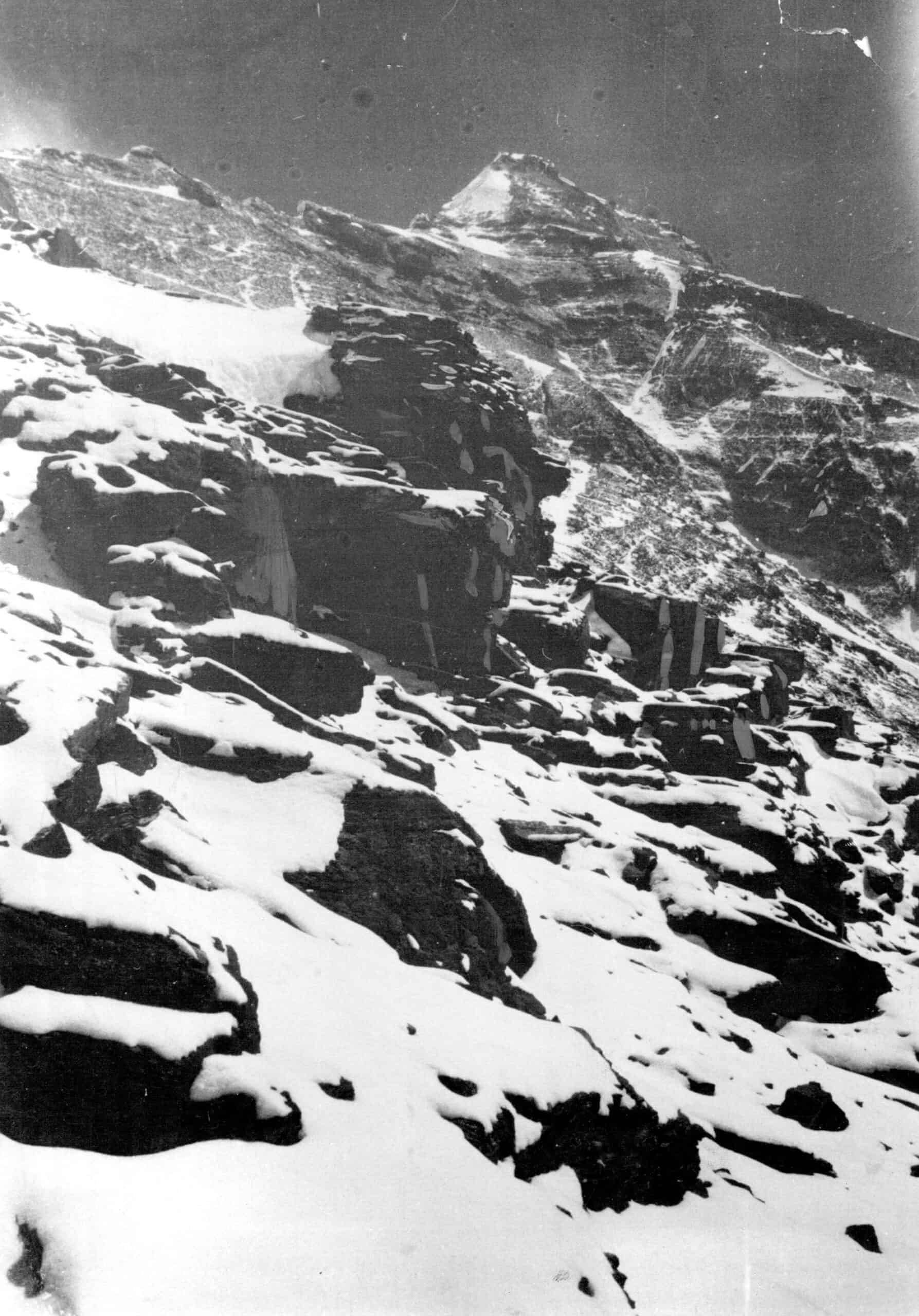
So, to me, the "base of the final pyramid" in 1924 must have included the Third Step as we know it today. As a climber, looking up it would be obvious that the First and Second Steps would be challenges, but the Third Step is almost quite obviously not an issue and can be passed easily on its western flank. So, for me, I still think Odell's description points us to the Second Step - or near it - for that final sighting. But, as always, there's a whole lot of speculation in this, and no concrete answers!
Thanks again, and be well!
Does it matter what Noel saw . I think it does not. If a pre determined narrative needs to be explained, that is how one will explain it. If you decide to support the narrative of a successful ascent, you will simply start defining the circumstances differently. Hence, what one presumes is what one defines. Hence, unless we get substantial proof of what actually happened on 8 Jun 1924, everything is speculation....as per our assumptions....a waste of time
Does it matter what Noel saw . I think it does not. If a pre determined narrative needs to be explained, that is how one will explain it. If you decide to support the narrative of a successful ascent, you will simply start defining the circumstances differently. Hence, what one presumes is what one defines. Hence, unless we get substantial proof of what actually happened on 8 Jun 1924, everything is speculation....as per our assumptions....a waste of time
Hi Vikramjit, thanks for your thoughts and comment! I agree in part with your thoughts, i.e. that all is speculation for the most part. But, I don't necessarily believe it is a waste of time, as the more we ponder it, the more we can individually and collectively consider what may have happened, and where to possibly look in future for signs of M&I. After all, much of what we knew going into our 1999 expedition was based on speculation as well, but that speculation led us into the basin where Mallory was found. So, not entirely a waste of time in my opinion! Thanks, and be well!
Dear Jake, Dear Dan,
Apologies for intruding with my comment more than a year after your discussion about the base of the pyramid, but here is some important detail that needs to be mentioned.
In The Mount Everest Dispatches of 1924 (the Alpine Journal No 229, November) Norton himself gives the definition of what the summit pyramid is. Namely, "...Their movements are shrouded in mist and mystery, but one brief note reached us yesterday from their perch near the top of the North Ridge by the hand of a returning porter. It is to the effect that Noel, with the kinema, should be on the look-out for them about the base of the final pyramid that starts 650 ft. from the top at 8 o'clock this morning."
That implies that the pyramid, as seen from 1924, starts from 28,352 ft (see p.217 ibid. where the height of the mountain is given as 29,002 ft), or 8647 metres. That is below the 3rd step which is at 8,710 metres (28,580 ft).
Now, it is in the same issue of the Alpine Journal, Odell famously notes (p.223) "The place on the ridge referred to is the prominent rock-step at a very short distance from the base of the final pyramid, and it is remarkable that they were so late in reaching this place."
Thus, Odell's MAY of course have meant the 3rd step given that 1) the 2nd step was referred to as such in other accounts of the expedition, and 2) "from the base" effectively means "from the spot where the base starts and onward, i.e. into the pyramid".
However, two arguments can be pitted against this suggestion. First, it would have been highly unreasonable for Odell to believe that reaching the 3rd step in circa 7 hours of climbing from Camp VI is remarkably late. Jake will surely provide more details on how quickly the 3rd step is usually reached nowadays from camps that are broken much higher up the mountain and much further west than Cape VI in 1924 (I am sure 7-8 hours would constitute an excellent progress to the summit!)
Second, from what we now know about the duo's probable rate of climb (judging by the approximate location where O2#9 was found) it transpires that the 3rd step was not within the duo's reach at the time of Odell's observation.
Best,
Maxim
Hi Jake,
I trust Odell. It seems silly but my brother is an arborist, and from quite a distance he can tell anyone exactly what tree you’re looking at, tell you the sub species and origins of that tree.
Odell knew rocks, he followed them with a great passion.
As you stated they spent months on the mountain, perhaps sketched it and also he climbed it. I don’t know in 1924 if they knew “ steps” as no one had gone that far, but I’m sure he understood the terrain.
I’ve read terrible things said about him and I think it’s very unfair.
Thank you for insightful thoughts, it’s all so fascinating!
Cheers- Barb
If you showed this photo to someone unfamiliar with modern nomenclature, they might perceive an additional "step" between the actual First Step and the Second Step. Phrases like "base of the final pyramid" are also quite vague. Even the upper part of the Second Step could be interpreted as the base. With clouds, perspective compression, etc. that smaller triangular feature in front of the Second Step could easily be mistaken for a "step".